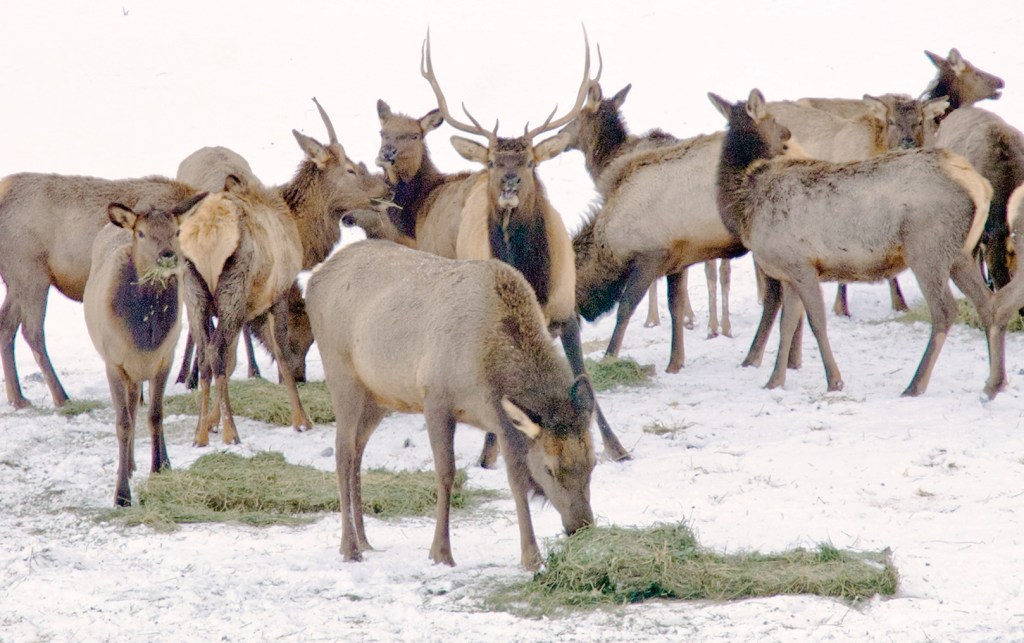Iconic, majestic: The elk
Published 12:47 pm Friday, September 27, 2019

- Rocky Mountain elk at a state-operated winter feeding site.
The elk: a great runner, an eater-upper of rough terrain, a beast that knits the Blue/Wallowa Mountain country together in its yearly rounds — summering in the high parklands and meadows, wintering in the foothills and valleys, following old hoof-broken travelways in between. And a beast tightly bound up in local human culture for millennia.
Trending
That “throat-singing” of the bugling bull elk — keyed into by his harem, his challengers, and his human hunters alike — is the sound of thousand of years of shaping by the landscape. Indeed, it’s the sound of the land itself: from the bygone Beringian plains to the here-and-now canyonlands of our backyard.
Our Northeast Oregon wapiti cover a great spectrum of topography and ecosystem in their journeying year: grazing subalpine meadows, calving in dense shady groves, wading up to their bellies in Ladd Marsh pools. They also call up the deep time of their ancestry and all their farflung relatives, from the Mongolian steppes to the Scottish Highlands. This time of year — as we listen to bulls bugling and stalk them with bow and rifle, and as the herds prepare for their fall migration — seems as good as any to ponder the elk’s backstory and specialness.
The nomenclatural confusion surrounding elk is probably familiar to many of you. In Europe, “elk” refers to what we here in North America call (after an Algonquin label) “moose”: the giant, gangly, cantankerous deer that lately has been colonizing our neck of the woods. The off-base label came from European colonists, who also variously called elk “gray moose” (as opposed to the true “black moose”) and “red deer,” a more understandable categorization given the close resemblance and genetic affinity between New World elk and Old World red deer.
(More on that later.)
As far back as the early 1800s naturalists were advocating for the American “elk” to be called the “wapiti,” after the Shawnee name for the creature that — right on point for its appearance — translates to “white rump.” I’m totally on board with wapiti: It’s an indigenous American name that eliminates all the moose-mixup confusion of “elk.” That said, “elk” is firmly entrenched, and I use both terms interchangeably.
The North American wapiti is the biggest and most advanced of the red-deer line. It’s an impressively adaptable generalist: a grazer of grasses, sedges, and forbs, but also happy to browse everything from shrubs to tree seedlings to lichen. It’s a lover of open spaces — mountain balds, prairies — but also fond of deep woods, the timber stringers of canyon and mountainside, long ago even colonizing the heavy forests of the East.
“Long ago,” though, is definitely relative. Notwithstanding their vast occupation of the North American continent at the time of European settlement — coast to coast, and from southern Canada down to Mexico — elk are among the newcomers of our fauna.
A 2014 study that conducted radiocarbon and genetic assessments of prehistoric elk remains from both Asia and North America shed some light on wapiti colonization of the New World. For much of the Late Pleistocene, elk (and moose, too) were apparently absent from the eastern parts of Beringia — the landmass encompassing the Bering Land Bridge and adjoining parts of present-day northeastern Russia, Alaska, and Yukon, part of the Ice Age “mammoth steppe” — while occupying its western reaches in northeastern Siberia.
The research suggests elk and moose didn’t cross over into Alaskan Beringia until about 15,000 years ago — in the waning days of the Pleistocene — coincident with a warming phase and an ecological shift toward more browse. Around 11,000 years ago, the seas reclaimed the Bering Land Bridge, separating Asian and North American wapiti; elk in northeastern Siberia, the source population for our wapitis, died out in historical times.
The 2014 study suggests the apparently significantly colder and wetter realm that prevailed in central Beringia formed an ecological barrier for elk preventing their eastward expansion until the end-Pleistocene climatic and ecological changes. Overall, a greater shrub component in eastern Beringia at the tail end of the mammoth-steppe days seems to have encouraged browsing wapiti and moose to “hoof” it over to North America — and may also have eased the way for people, the Beringian archaeological record for which roughly syncs with the elk’s timetable.
Taxonomists long debated whether Eurasian red deer — the classic “stag” of medieval art and story — and the wapiti of Asia (which include the Altai, Tian Shan, and Manchurian wapiti) and North America were the same species, but recent evidence suggests they’re distinct lines within the genus Cervus.
Compared with the red deer — generally a more forest- and woodland-haunting creature — the American elk grazes more. It’s also notably bigger: Indeed, it’s the biggest member of Cervus, with Roosevelt elk — the temperate-rainforest subspecies of the West Coast — attaining 1,200 pounds or more. (The biggest American moose, caribou, and brown bears also outsize their Eurasian relatives.) Our elk boast a more strongly contrasting coloration, the darkness of the face, mane (which — unlike in red deer — is sported not only by bulls but also by cows and calves), and legs set sharply against the tawny or reddish body. The American elk’s creamy rump patch, furthermore, is the most prominent of the red deer/wapiti.
The noted ungulate biologist Valerius Geist attributes many of these differences to the elk’s open-country origins, its striking pattern and running prowess similar to many savanna and grassland antelope. (Emphasizing the American elk’s speed and stamina, Theodore Roosevelt wrote, “Wapiti have a slashing trot which they can keep up for infinite time over any kind of country. Only a good pony can overtake them when they have had any start and have got settled in this trot.”)
Wapiti antlers are longer and larger than the headgear of a red-deer stag, though the latter’s rack is proportionately bulkier, and are on a six-point plan compared to the red deer’s five-point one. The lengthy beam, long dagger tine, and terminal forking seen in a typical bull elk’s antlers make them an effective long-distance signal during the rut, as the late deer specialist Anthony Bubenik noted: Even a subtle nod of a displaying bull can be detected from far off in open country because of the ornate rack.
Of course, the best-known long-distance signal employed by a bull elk is its bugle: also one of the clearest differences between it and a red-deer stag. The rutting stag emits a deep, full-throated roar compared to the higher, more strangled wapiti bugle. Like the elk’s bolder hide, the bull’s bugle is an adaptation for open ground, its higher pitch traveling farther than the forest-adapted stag’s low, husky bellow.
But there’s a bit more to it than that. Anyone who’s heard a bugling bull up close knows the two-toned nature of the screech. A 2016 study published in the Journal of Experimental Biology examined the sonics of the elk’s bugle, and showed it indeed comprises two different pitches: a low one produced in the vocal tract that averages about 145 Hertz overlaid by an “aerodynamic” whistle averaging 1426 Hz. The authors of the study speculate the low-frequency part of the bugle helps convey the bugling bull’s size to nearby rivals, while the whistle is the long-distance advertisement.
That “throat-singing” of the bugling bull elk — keyed into by his harem, his challengers, and his human hunters alike — is the sound of thousand of years of shaping by the landscape. Indeed, it’s the sound of the land itself: from the bygone Beringian plains to the here-and-now canyonlands of our backyard.









